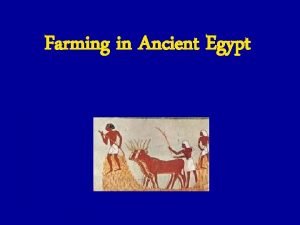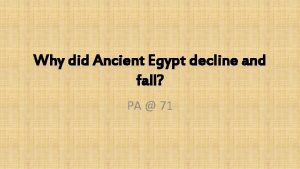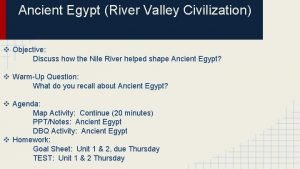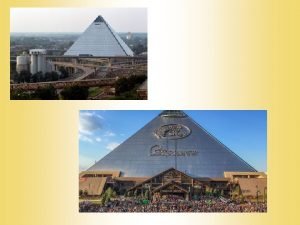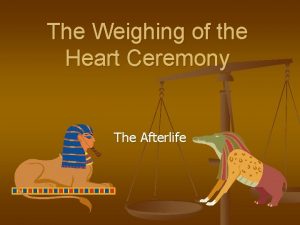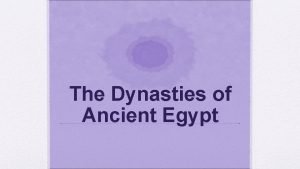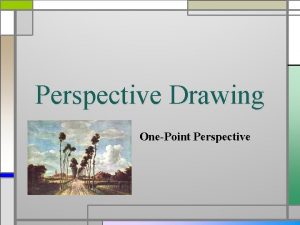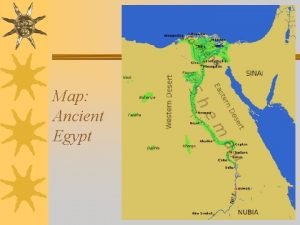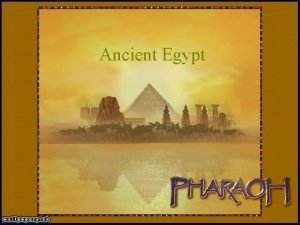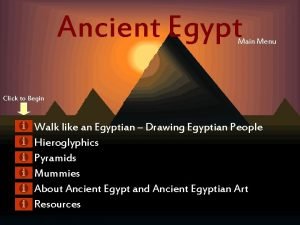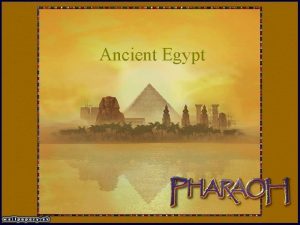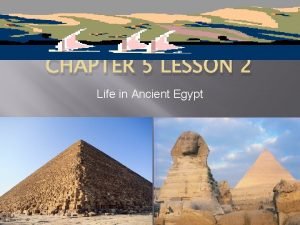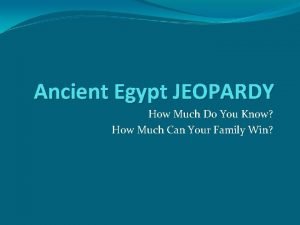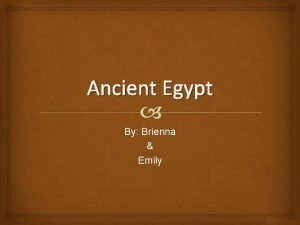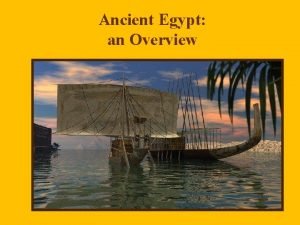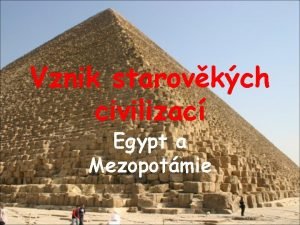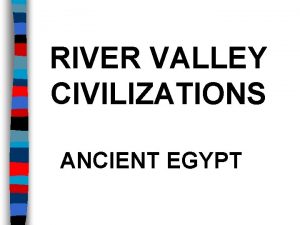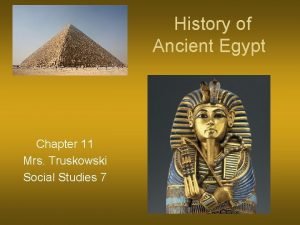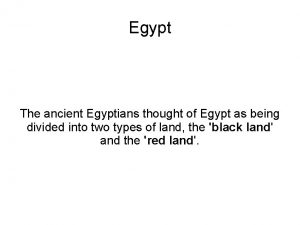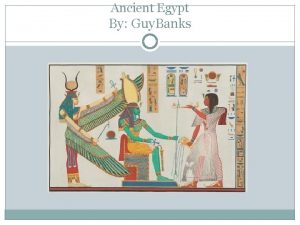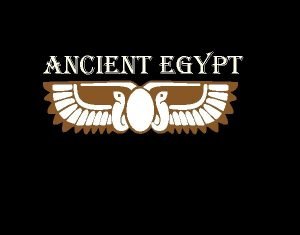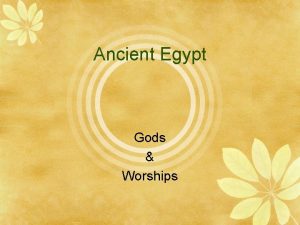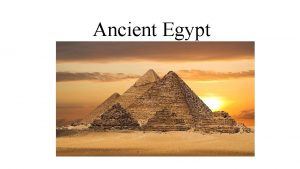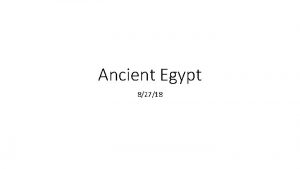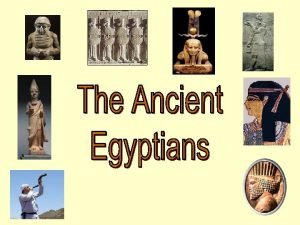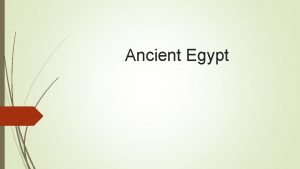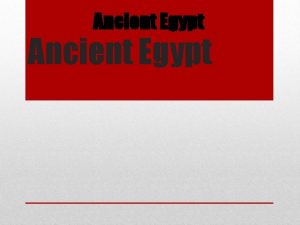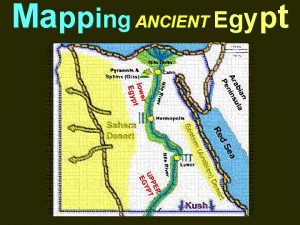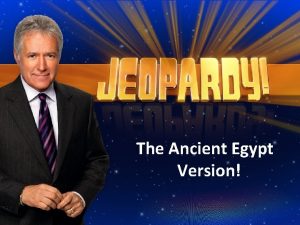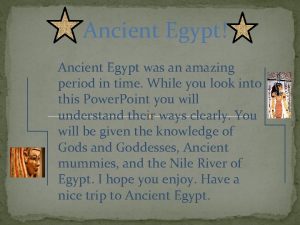Scientific Innovation Ancient Egypt Mathematics How Egyptians did




![Fractions ► (er, "[one] among" or possibly re, mouth) above a number to represent Fractions ► (er, "[one] among" or possibly re, mouth) above a number to represent](https://slidetodoc.com/presentation_image_h/98874393284e77b1cbf5f89818248b19/image-5.jpg)




























- Slides: 33

Scientific Innovation Ancient Egypt

Mathematics ► How Egyptians did mathematics ► Unlike our math, Egyptians did not memorize, carry or borrow ► They used a binary system: system of 2

How numbers looked

Base Ten System The Egyptians invented a decimal system. They used 7 different symbols. ► 1 was represented by a single stroke. ► ► 10 was shown by drawing one hobble. ► 100 was shown with a drawing one coil of rope. ► 1, 000 was represented by a drawing of one lotus plant. ► 10, 000 was shown as one finger. ► 100, 000 was represented by a drawing of one frog. (A hieroglyphic of six frogs in a row would mean 600, 000) ► 1, 000 was represented by the figure of a god with raised arms
![Fractions er one among or possibly re mouth above a number to represent Fractions ► (er, "[one] among" or possibly re, mouth) above a number to represent](https://slidetodoc.com/presentation_image_h/98874393284e77b1cbf5f89818248b19/image-5.jpg)
Fractions ► (er, "[one] among" or possibly re, mouth) above a number to represent the reciprocal of that number. Similarly in hieratic script they drew a line over the letter representing the number. For example: 10 = 1 3 = 1 The Egyptians had special symbols for 1/2, 2/3, and 3/4 that were used to reduce the size of numbers greater than 1/2 when such numbers were converted to an Egyptian fraction series. The remaining number after subtracting one of these special fractions was written using as a sum of distinct unit fractions according to the usual Egyptian fraction notation.

How we know • The Ahmes papyrus is 6 metres long and 1/3 metre wide • It was purchased by Egyptologist Henry Rhind in 1858 • It dates to about 1850 BC

Eye of Horus = the complete eye = 1 / 8 = 1 / 2 = 1 / 16 = 1 / 64 = 1 / 32 = 1 / 4 Eye of Horus as explained in the Ahmes instructional for apprentices

Slab stela of Old Kingdom Egyptian princess Neferetiabet (dated 2590 -2565 BC) from her tomb at Giza, painting on limestone, now in Louvre, France. Can you find the numerals?

The Calendars ► Egyptians used solar, stellar, lunar and civil calendars ► The earliest calendar was the lunar calendar ► It had 360 days, 3 seasons made up of 4 months each 30 days long ► The seasons followed the cycles of the Nile River: AKHET (Inundation) June 21 - October 21 PERET (Emergence) October 21 - February 21 SHEMU (Summer) February 21 - June 21

The year begins … ► The “opening of the year” was signaled by the appearance of the star Sirius in the constellation Canis Major near or on June 21 ► This constellation was called “the going up of the goddess Sothis” by the Egyptians ► Visible just before sunrise, this is still one of the brightest stars

360 + 5 = 365 Days ► Although the Egyptian formal calendar was 360 days, they had 5 days set apart for celebrating the beginning of a new year ► “the yearly 5 days” were full of feasting, celebration and rituals ► Because they did not account for a leap year, their calendar and the seasons gradually became out of step ► By the end of the old kingdom there was a 5 month discrepancy!!

More order was needed ► Administrators needed a more simple calendar that did not rely on priests looking at the sunrise to determine when a month starts ► A calendar that had the same number of days in every month and the same number of months in every year was needed

A Civil Calendar is introduced ► 12 months each with 30 days in 3 ten day weeks ► Followed by 5 days of public holidays to give 365 days in a year ► The holidays celebrated the births of Osiris, Isis, Horus, Nephthys and Seth ► A leap year still did not exist

The Civil Calendar AKHET (the time of flooding) June 15 - October 15 Inundation ► 1 Thoth. . . June 15 - July 15 2 Paophi. . . July 15 - August 15 3 Athyr . . . August 15 - September 15 4 Khoyak. . . September 15 - October 15 PERET (the time of sowing) October 15 - February 15 Emergence ► 1 Tybi………. . . . October 15 - November 15 2 Mekhir……. . . . November 15 - December 15 3 Phamena. . . . December 15 - January 15 4 Pharmuti…. . . . January 15 - February 15 SHEMU (the time of harvest) February 15 - June 15 Summer ► 1 Pakhons. . . . February 15 - March 15 2 Payni…………. March 15 - April 15 3 Epiphi. . . . . April 15 - May 15 4 Mesore…………………May 15 - June 15

The hours ► Unlike most ancient civilizations, the Egyptians began and ended their days at sunrise ► Day was 12 hours, numbered 1 to 12 ► Night was 12 hours, number 13 to 24 ► However, during the summer the day was longer in hours than the night and during the winter the hours in the night were longer ► They used a sundial during the day and the stars at night because it was always clear

Using the stars and beyond ► Different stars rise at different times during the night so they could tell which hour it was using astronomy ► Stars on the ceilings of the tombs were there so the dead kings could tell time in the afterlife!! ► Eventually, the Egyptians used water clocks (clepsydra) ► The clepsydra enabled Egyptians to tell time whether it was dark or light, cloudy or clear ► Its hours too varied with the seasons

Clepsydra (at least 15 th C BC or older) Who invented them no one knows http: //www. britannica. com/clockworks/clepsydra. html

Egyptian firsts Stellar Calendar www. webexhibits. org/calendars/calendar-ancient. html http: //abyss. uoregon. edu/~js/ast 123/lectures/lec 01. html ► They were the first to use a 24 hour clock ► Make a calendar that followed the seasons and the sun http: //mummyswrap. com/2010/02/03/the-ancient-egyptian-calendar/

Solar Calendar The time when the Nile floods depends upon the time taken for the earth to make a complete revolution around the sun ► Our solar revolution is 365 ¼ days so we add an extra day every 4 years (leap year) ► But early Egyptians used two heliacal risings of the constellation Serpet (Sirius) rather than the solar cycle, there year was 12 minutes longer than solar year ► That meant that their stellar calendar lost a day only every hundred years compared to the loss of 1 day every four years in the solar calendar ► The heliacal rising of a star is its first appearance in the Eastern sky at dawn. Over a sidereal year, the star will rise earlier and earlier until it sets at dawn, followed by a period of 70 days when it is no longer visible by dawn, before the cycle begins again.

Solar Trumps Stellar ► By the time the stellar and solar calendars had the start of inundation out by more than a few days, Egyptians had realized that the flooding of the Nile was dependent on the solar cycle and not the stars ► They measured the solar year by this point in a way that was more precise than the Julian calendar ► The Julian calendar has a leap year every four years and wasn’t adopted until 4000 years later!!

Unable to Change the Civil Calendar. . . ► Egyptians still formally recognized Ahket (June 15) as beginning with the heliacal rising of Serpet, based on the old calendar ► But in practice, used the new solar calendar to predict the actual date of inundation How does are method of time and calendar compare with what was used by the Ancient Egyptians 4000 years ago?

Medicine in Ancient Egypt ► Can be traced back to 1600 BC ► The health of the people was a religious obligation ► We know this thanks to various papyrus found in the tombs

Doctors in Ancient Egypt were highly respected and of high status Early doctors appear to have been priests because temples had their herb gardens to provides a supply of medicines ► Medicine was within the realm of the priesthood ► For example, Imhetop was an architect, priest and doctor ► Were good broken bone setters and practiced amputation successfully, including prosthetics ► Wounds and cuts were treated with bandages soaked with antiseptic herbs and ointments ► Their materials were mostly plant-based ► Were the best in their time: each doctor specialized in treating different parts of the body ► ►

Papyrus Ebers ► Is more than 20 m long and 30 cm wide!! ► Includes names of the spleen, the heart, the anus, lungs, etc ► Is mainly a reference guide for internal medicine ► Details diseases of the eye, skin and extremities ► Talks about gynecology and some surgical diseases ► Includes anatomical and physiological terminology ► 877 recipes and 400 drugs were described for treatment http: //www. crystalinks. com/egyptmedicine. html

The Edwin Smith Papyrus ► 5 m long with a focus on surgeries ► 48 surgical cases of wounds of the head, neck, shoulders, breast and chest ► Listed cases and individual treatments ► Included numerous fracture treatments Why would that be http: //www. crystalinks. com/egyptmedicine. html

Kahun Gynecological Papyrus ► Discovered at Faiyum and is dated to be created during the 29 th year of the reign of Amenenhat III (c. 1835 BCE) ► Details conception, contraception using crocodile dung, honey and sour milk ► Testing for pregnancy: one method was to insert an onion bulb deep in the woman’s flesh and if the odour reached the patients nose they were deemed pregnant ► Another section deals with treating ailments of pregnant women

Examples of treatments ► ► ► ► Using castor oil as a laxative Powdered mandrake and henbane were used as painkillers (opium was imported from Cyprus during the New Kingdom) Splints were used to heal broken bones (they knew the difference between a simple and multiple complex fracture) Performed delicate surgical procedures such as relieving pressure on the brain Success was due to rigid procedures to maintain cleanliness through a routine purification ritual performed on the patient before treatment Gold was used to bind lose teeth and filled them with a kind of mineral cement All treatments were accompanied by specific incantations and spells which would rid the patient of evil spirits

Known ailments and diseases Cancer – cervical and breast has been found in mummies ► Abscesses and cysts ► Piles ► Tuberculosis ► Night blindness, cataracts, other eye diseases ► Migraines and headaches ► Urinary tract infections and strictures ► Breathing difficulties - there is a relief of a tracheotomy ► Sciatica ► The list goes on ►

Medical Kit (1) knives; (2) drill; (3) saw; (4) forceps or pincers; (5) censer; (6) hooks; (7) bags tied with string; (8, 10) beaked vessel; (11) vase with burning incense; (12) Horus eyes; (13) scales; (14) pot with flowers of Upper and Lower Egypt; (15) pot on pedestal; (16) graduated cubit or papyrus scroll without side knot (or a case holding reed scalpels); (17) shears; (18) spoons. http: //www. crystalinks. com/egyptmedicine. html

Sample Ailments and their Treatment ► Everyday complaints like stomach upsets, bowel trouble and headaches went probably mostly untreated, even if the physicians could offer remedies: For the evacuation of the belly: Cow's milk, 1; . grains, 1; honey 1; mash, sift, cook; take in four portions. To remedy the bowels: Melilot (? ), 1; dates, 1; cook in oil; anoint sick part. To refresh an aching head: Flour, 1; incense, 1; wood of wa, 1; waneb plant, 1; mint (? ), 1; horn of a stag, 1; sycamore (? ) seeds, 1; seeds of [ (? )], 1; mason's plaster (? ), 1; seeds of zart, 1; water, 1; mash, apply to the head. To renew bowel movements in a constipated child: An old book, boil in oil, apply half on the belly to reestablish evacuation. Ebers Papyrus G. Maspero, Etudes de mythologie et d'achéologie égyptiennes III, 1898, pp. 289 f.

► To treat the common cold their remedy was to have the patient drink the milk of a mother who has given birth to a boy ► The spell to go with it is as follows: May you flow out, catarrh, son of catarrh, who breaks the bones, who destroys the skull, who hacks in the marrow, who causes the seven openings in the head to ache. Ebers Papyrus

Eye Infections Prescription for the eye, to be used for all diseases which occur in this organ: Human brain, divide into its two halves, mix one half with honey, smear on the eye in the evening, dry the other half, mash, sift, smear on the eye in the morning. Ebers Papyrus G. Maspero, Etudes de mythologie et d'achéologie égyptiennes III, 1898, p. 290.

For Reference and Further Exploration ► King Tut Shop. www. kingtutshop. com ► Ancient Egyptian Medicine. http: //www. king -tut. org. uk/ancient-egyptians/ancientegyptian-medicine. htm ► http: //www. crystalinks. com/egyptmedicine. html ► http: //www. reshafim. org. il/ad/egypt/timelin es/topics/medicine. htm
 Ancient clothing egypt
Ancient clothing egypt What crops did the egyptian farmers grow
What crops did the egyptian farmers grow How did the nile shape ancient egypt
How did the nile shape ancient egypt What does ancient egypt
What does ancient egypt How did the nile shape ancient egypt dbq answer key
How did the nile shape ancient egypt dbq answer key Upper egypt and lower egypt
Upper egypt and lower egypt Mysite socccd
Mysite socccd Incremental innovation vs disruptive innovation
Incremental innovation vs disruptive innovation Thoth weighing of the heart
Thoth weighing of the heart Early american floral arrangements
Early american floral arrangements Ancient egypt vocabulary words
Ancient egypt vocabulary words Ancient egyptian frontalism
Ancient egyptian frontalism Ancient egypt british council
Ancient egypt british council Specialized jobs in ancient egypt
Specialized jobs in ancient egypt Ancient egypt
Ancient egypt Outline map of ancient egypt
Outline map of ancient egypt Ancient management
Ancient management Ancient egypt transportation
Ancient egypt transportation Nubia geography
Nubia geography Ancient egypt social hierarchy
Ancient egypt social hierarchy What is frontalism
What is frontalism Egypt map
Egypt map Ancient egypt society
Ancient egypt society Trophic levels
Trophic levels Ancient egypt non chronological report
Ancient egypt non chronological report Social classes in ancient egypt
Social classes in ancient egypt Jeopardy ancient egypt
Jeopardy ancient egypt Ancient egypt basic needs
Ancient egypt basic needs The three kingdoms of ancient egypt
The three kingdoms of ancient egypt Kleopatra hrobka
Kleopatra hrobka Workbook page 19
Workbook page 19 Natural barriers of china
Natural barriers of china Egypt god of healing
Egypt god of healing Timeline of ancient egypt
Timeline of ancient egypt

